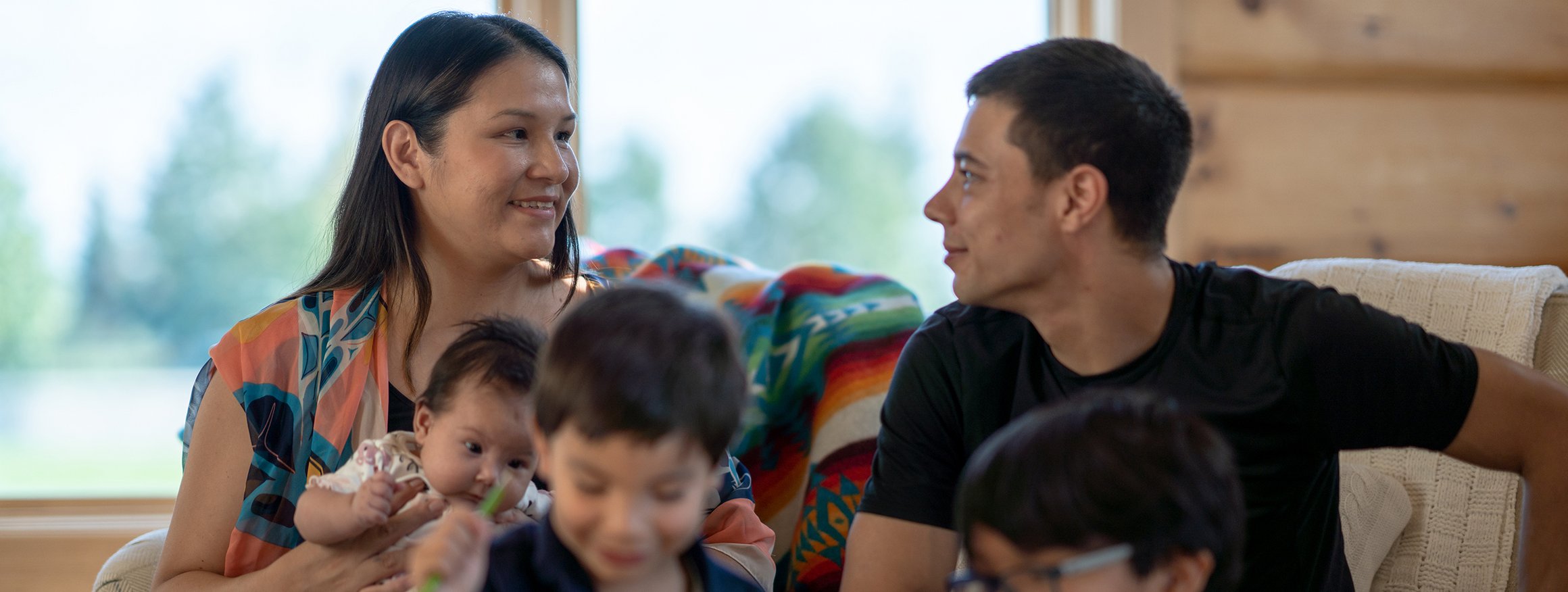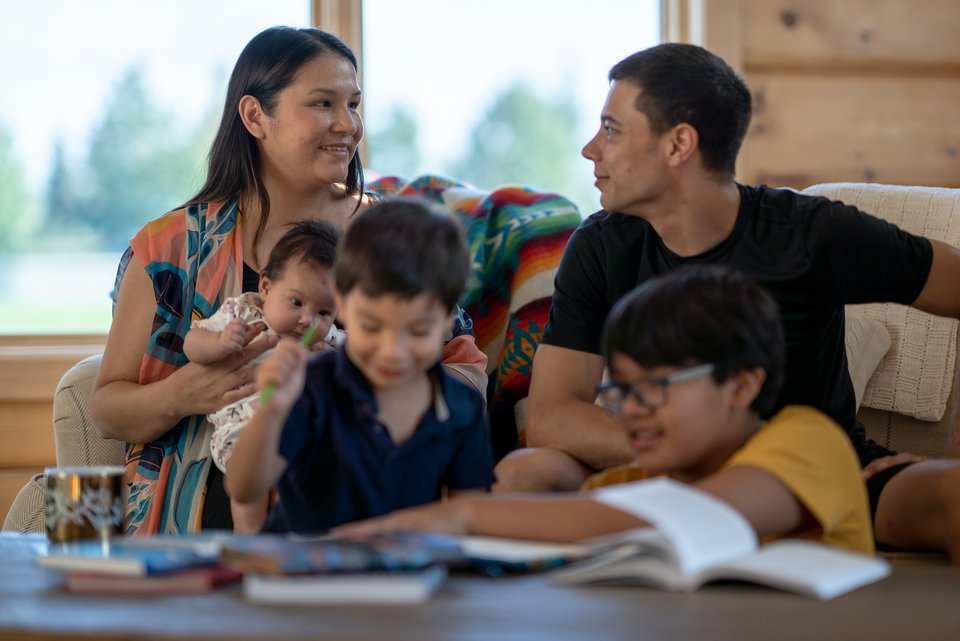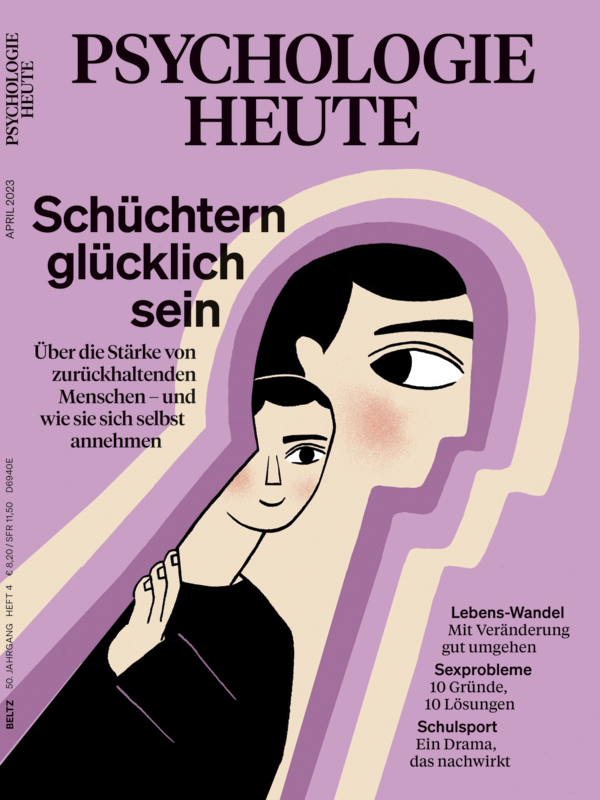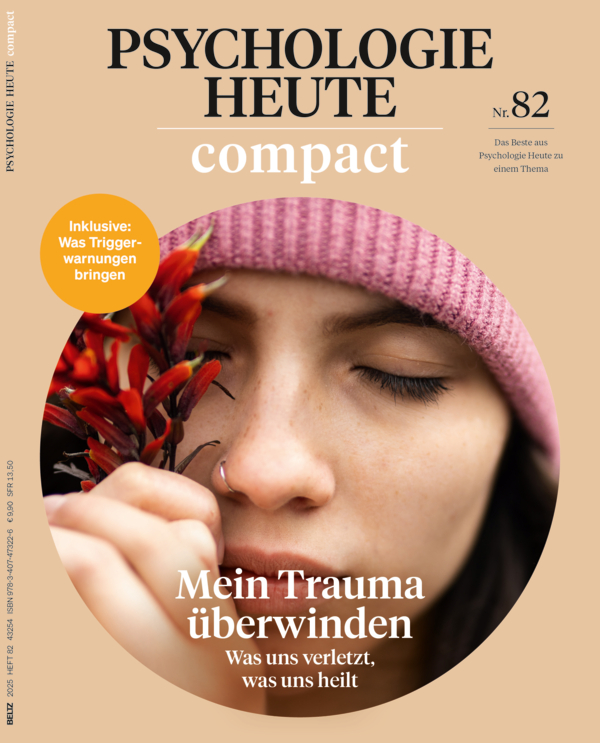Für das Editorial zu unserer Ausgabe „Schüchtern glücklich sein“ kontaktierte Chefredakteurin Dorothea Siegle die kanadische Psychologin Erin Gurr. Diese hat erforscht, wie Schüchternheit in Indigenen Gemeinschaften im Norden Amerikas wahrgenommen wird. Anders als in westlichen Gesellschaften wird Schüchternheit dort oft nicht als Makel, sondern als wünschenswerter Charakterzug empfunden. Da die Frage der Beschreibung Indigener Gemeinschaften durch die westliche Brille ein komplexes und vieldiskutiertes Thema ist, bei dem es auf die Wortwahl ankommt, stellen wir das E-Mail-Interview mit Erin Gurr hier für alle Interessierten im Originaltext auf Englisch zur Verfügung.
Why are personality traits viewed differently in Indigenous societies and in Western ones?
There are multifarious reasons as to why this is, but the most straightforward way to conceptualize it is in terms of differences in our epistemologies. Namely, that Western societies typically construe human development and time itself as proceeding in a linear fashion; although recent theories discuss the inconsistencies surrounding this assumption (both in the disciplines of human development and of course in the world of theoretical physics), generally speaking the belief is that time unfolds chronologically, and that human development can be charted in a roughly similar fashion.
In the Indigenous worldview, neither of these assumptions hold much currency. Human development is very much tied to the health and growth of the natural environment, and as such the development of one’s personality or the expression of their personality could be altered by dramatic changes to the health and functioning of their surrounding ecosystem. There is also this notion of the circularity of time and thus of human development itself; of aspects of one’s personality having been an inheritance of one’s own culture, and of the previous generations; there is strong belief and expression of recapitulation and of reincarnation within family and community systems.
This concept is even prevalent to a large degree in Métis cultures, where we see strong practices of syncretic Roman Catholicism. You are of course your own self, but you are also to a large degree, your ancestors, too. It is interesting to see modern science catching up to this form of ancient wisdom, in discussions of epigenetic transmission of intergenerational trauma, for example.
Greek and Roman cosmologies also typically place man at the centre of anything; in the period of enlightenment in Europe man was decentered so to speak, but enduringly, and particularly in the Christian worldview, humankind is still in some sense placed above the animal and natural world, which are rendered as tools God created for humankind’s usage.
Native epistemologies do not centre man, and in fact use various zoocryptological characters in their mythology to describe and embody the overlapping characteristics and embodied experiences of humans and the animal/natural world. I mention this because, in these zocryptological beings, we see evidence of an assumption that this concept of personality is not tied to individual human beings alone; In shamanistic and pagan belief systems, everything is in a sense alive, including what Westerners construe as inanimate objects, like plants, water, and even geological formations.
These organic materials are embodied with life and a spirit of their own, and this is important to understand with respect to the Indigenous worldview because humankind is always, according to these belief systems, in a constant dialogue with the world around them, and actively being shaped by it; as such, human behavior is very much shaped not by intrinsic personality traits or even the human community they share, but also the environment itself and its condition.
What does being mentally ill mean within Indigenous societies compared to our Western idea of it?
There are as many answers to this question as there are Indigenous societies around the world, which number in the hundreds of thousands. Therefore, it is difficult to provide one single crosscutting answer; however, one description of mental illness comes from the Inuit, which diverges tremendously from the Western conception in that it describes mental illness not as something emerging from within the individual or even necessarily centered in the brain, which is the seat of the personality and reasoning faculties in Western reckoning; that reasoning invokes a somatic, biological explanation and presentation of mental illness.
In Inuit cultures, mental illness or malaise could also be described as an essence which one can “catch” from another human being, or from the surrounding environment; that is why there is tremendous respect and also a healthy amount of fear associated with the Aurora Borealis in many circumpolar cultures in Inuit and Sami cultures; for some cultures, the Aurora demonstrates powerful evidence of the spirit and essence of their ancestors, one which actively watches over them but also in a sense stands in judgement, and one ought not to get to close to it for fear they might lose their faculties of reasoning; as it is a force which contains many spiritual entities, over centuries, across the history of humankind.
To return to your first question about the view of personality and tie it to this question about mental illness, there is also a strong belief in Inuit culture that when an Inuit person dies, they will often choose to be reincarnated within their own family system, or culture; this belief is prevalent in the Tibetan Bon religion as well. It is important to know this for two reasons; one, it ensures cultural and familial continuity; and two, in the practice of giving an Atiq (or soul-name), the living will gift new life with the personalities and life essence of their dearly departed.
In Inuit culture there is a strong belief that personality traits come from the name one is given, particularly in the Atiq form; and one can even share personality traits or an essence with others simply who bear the same name as them. This is a very unusual concept in Western Psychology, because we largely subscribe to the notion that personality is inborn. So, to return to this idea of mental illness deriving from outside of oneself, unfortunately we also have the possibility of inheriting mental illness or a bad temperament if our chosen Atiq had these characteristics themselves. This unfortunate scenario is certainly one I have heard of before.
Finally as described in our article Perspective on shyness as Adaptive from Indigenous Peoples of North America, there is the central Inuit concept of the emotion-construct Isumaluttuq, which implies “difficulty with thought processes” or “taking leave of one’s intelligence or senses” which would likely be labeled as mental illness within Western cultures. Viewed as a state of mind, Isumaluttuq can change as rapidly as a person’s mind and experiences.
Thus, the idea of a person being inflicted with serious mental illness (Isumaluttuq) is conceptualized as a transitory experience, which shares common linguistic features with the way Inuit people frame the experience of emotional states, as opposed to the Western notions that often conceptualize mental illness as enduring.
Why is shyness among Indigenous persons often labeled as problematic by Western psychologists? Can you give me an example in which situations it is or was misinterpreted and perhaps even medically treated?
Researchers in Social Psychology state that the presentation of personality is often discerned last, when dealing with cultural group members who are not familiar to the observer; the cultural features are often most salient, and this is in fact why, when meeting an individual from a culture with whom we are not familiar, we might attribute many of their behaviors or attitudes, erroneously, to their culture; instead of their personality. But, to discuss the specific scenario of a Western Psychologist visiting an Indigenous community, if the outsider is not familiar with the culture to begin with, how could they even begin to distinguish between cultural presentation and actual personality traits?
What Western psychologists initially perceive as a shared personality trait of shyness (a problematic concept in and of itself) among a group of children who share the same culture, may in fact be a hesitancy to disclose or engage their problems with someone perceived as having the ability to rupture their ties to their school, community, and family. It may in fact be, that the psychologist is not perceiving the child’s true personality at all. So, this could potentially be a reason why non-Indigenous consultants who work with Indigenous children and communities, perceive that they are shyer as a group than their non-Indigenous counterparts.
But, this shyness could potentially be described more as a natural distrust or wariness of “expert outsiders” – there is a long history of abuse, mis-or underdiagnosis, and medical neglect or malpractice in the primary healthcare and mental health fields in Indigenous communities, and a certain amount of “medical mistrust” has developed. The shyness presentation may also be characterized as a respectful deference to an older person, which is an important cultural value in many Indigenous communities; or an attempt not to burden a guest to the community with experiences or perceptions that might make them uncomfortable; there is a natural inclination towards hospitality for many Indigenous communities.
In the book chapter you mentioned, you name several reasons, why behaviour, that reflects shyness or inhibition, is highly valued within Indigenous cultures – can you explain them to our readers?
As counterintuitive as it might seem to the Western world, in certain Indigenous cultures, the trait of being extroverted, emotive or talkative may not necessarily be viewed in a positive light. Again, you have to think back to the philosophical roots of our respective epistemologies. Western culture is largely dialectical; it values debate and the refinement of one’s personal expression and individuality, which comes from the traditions of Ancient Greece.
There are many Indigenous societies in North America which have specific oratorical traditions, such as can be found in Cree communities – I highly recommend Tomson Highway’s nonfiction and fictional work for individuals who would like to delve more deeply into this topic – but it doesn’t necessarily take the form of a dialectic or debate; stories and songs are woven across generations, and are altered according to the speaker and their household, their community. It should be restated again, at this point, that it is difficult to point to a core value of shyness/inhibition amongst Indigenous societies the world over – in North America and beyond – and I am sure there are Indigenous cultures on other continents or even within North America itself which view this argument with increasing weariness and disdain, because it essentializes or misrepresents the complex oratorical traditions of their culture.
As discussed in our chapter, in some Indigenous North American societies, children were expected to restrain themselves from expressing strong feelings such as joy, anger, and fear as well as controlling hostile and aggressive behavior. This is not to say that Indigenous societies do not value or engage in display of emotion at critical moments, or are themselves not competitive; there is an important distinction to be made here, between competitiveness, and the values of collectivism, which many Indigenous societies hold in common.
One of my favourite Clinical Psychology researchers of Indigenous ancestry is Dr. Joseph Gone, a Gros Ventre tribe member currently based out of Harvard University, who recently wrote an article, in which he plaintively states that there is a serious misconception perpetuated by historic and modern anthropology, that Indigenous peoples are inherently egalitarian, to an extreme degree where individual differences are not tolerated or are ameliorated by an ecocentric worldview or collectivist social values; this is simply not true. He goes on to state that within his own culture, there is a great tradition of competitiveness particularly as regards the concept of “counting coop” and of sharing the mastery of difficult physical activities for the implicit purpose of social comparison (such as the building of social capital).
As a woman whose grandmother was of partial Lakota ancestry, I found myself strongly relating to his description of these lesser known aspects of American Plains Indigenous cultures. The essential difference is that collectivism describes a socioeconomic system which guides and mediates the sharing of material resources equally amongst tribe members; whilst individualism more directly centers competitive behaviors and indeed this often extends to the distribution of economic resources as well. It is important to remember that valuing humility to lesser or greater extents does not presage the presence of social competition in our societies.
What role does shyness play in raising children in Indigenous societies?
One fundamental concept which is seen across several different Indigenous societies is the valorization of self-abnegation or humility, which is a distant although related attribute to this Western personality construct of shyness. Indigenous cultures have different ways of imparting the attribute of humility and deference towards elderly people and group mores, but one very common approach is to use humor in the form of chiding or teasing, which usually occurs in a sort of dialectic, with the child engaging in role playing of adult responsibilities, or, in some cases, breaking social taboos – to which the parent will respond by gently reminding them of what one is and is not to do, in each particular new scenario that the child is attempting to imitate.
The manner in which this is done, as I said, depends on the culture; the Inuit use teasing as a way to allow the child to formulate the idea of a social taboo for bad/presumptuous behavior, without simply reciting dictums, punishing, or other forms of discipline. It is a very different approach to child rearing which has gained much more attention in the research literature in recent decades, but the first true anthropological study to document this form of childrearing among Inuit is the classic Never in Anger: Portrait of an Inuit Family (the word she erroneously uses is Eskimo, in the original title).
Can that also be a burden for children who are especially extraverted?
This is a very interesting question. Culture is highly fluid and dynamic, and it changes based upon encounters with people from other cultures, from technology and social media, etc. In truth, I have observed that the current generation to come of age is highly outspoken and idiosyncratic in their personal expression as compared to their parents and grandparents.
When I returned North as an adult to perform research, I met up with some of my former classmates, their children and grandchildren; and I was shocked by the forwardness. In some instances, they were being outright disrespectful to their mother, who is of Canadian Inuit ancestry – and speaking to her in ways which formerly I think would have been forbidden; certainly children would have been chided, teased for taking even the hint of a contradictory tone with an adult, particularly with elders. I have also observed similar ways of communicating for the younger generations of Métis and First Nations children; again, it is difficult to pinpoint exactly why this may be, but it does appear as though the presence of social media in English, has strongly influenced the way that the current generation communicates, and it seems in some instances to have primacy over cultural mores.
This is to be expected, because we know as researchers in the Developmental Psychology field that for adolescents, the peer group proves to be more influential on behavior and attitudes than the parental and caregiver units. Where formerly this dictum could not be said to apply to Indigenous communities, with the family at the centre of everything – now the nuclear family and their prominence in the child’s life, looks rather different, even compared to how it looked in the 1990’s! So, to summarize, I believe that to be an extrovert in an Indigenous community now, would look and be received very differently than in previous eras.
I often wonder if shyness or inhibition presentation amongst children of Indigenous ancestry is in some way a manifestation of a language barrier or a direct result of the government’s genocidal language policies. Many Métis, First Nations and Inuit people (myself included) have grandparents who spoke Indigenous languages as their mother tongue. My own grandmother was often described as chronically shy by outsiders, but anyone from her family – particularly those who spoke her languages fluently – would tell you otherwise!
Surely the abrupt generational shift from a multitude of oral language forms to predominantly English (or Danish, or Russian, etc. as the case may be) must have some kind of lasting impact upon how we conduct ourselves around cultural insiders or someone who comes from a long line of English (or Danish) speakers.
Can an Indigenous person profit from the different perspectives on personality and especially on shyness? Or does it usually mean stress and anxiety?
Another interesting question; I presume by “different perspectives” you refer to Western or Indo-European Psychological conceptualizations of trait shyness inhibition; if this is the case, I strongly suspect that for those cultural groups who have been exposed to the English language, there is already prevalent a strong conceptualization of shyness as a potentially debilitating or in the most adverse scenario, unwanted, personality trait; as it is typically described as “fear of social judgement to an extreme, pathological degree”.
I would argue that many Indigenous communities are likely already familiar with this construct, and in fact there have been some recent illuminating discussions and research on construct shyness in Western, North American societies as compared to Indigenous, historically collectivist communities; one such article, authored by clinical psychologist Dr. Denise Newman, who is of Anishinaabe origin, wrote about shyness/inhibition as an adaptive social skill amongst the Lumbee of North Carolina. It is interesting to ponder whether this meta-awareness could be a cause of anxiety, stress, or frustration for an Indigenous person.
I think many Indigenous people naturally engage in cultural code switching and in Two Eyed Seeing, in that we are aware of these Canadian/North American perceptions of certain behaviors or attributes, but we do not necessarily internalize them as “normative” or “the norm” per se, they exist alongside of our internalized conception of, for example, a shy person; and we can adjust our behaviors based upon the context, or who we are standing in front of. If anything, I would argue for individuals of Indigenous ancestry to make closer connections and deeper cultural understandings of what shyness means in their own culture and language family, as that is what we are most in danger of losing.
Erin Gurr ist Psychologin an der McGill University in Montréal in Kanada.
Erwähnte Indigene Gemeinschaften
Die Métis sind vor allem in North Dakota und Minesota niedergelassen.
Die Inuit sind vermutlich eine der bekanntesten Indigenen Gemeinschaften. Sie leben heute überwiegend auf Grönland, in Alaska, Nordkanada und Sibirien.
Die Indigene Gemeinschaft der Sami lebt überwiegend in Norwegen, Schweden, Finnland und Russland.
Die Cree sind vor allem in Canada angesiedelt. Sie bilden eine der größten First Nations des Landes. First Nations ist eine Bezeichnung für alle Indigenen Gemeinschaften Kanadas.
Ebenfalls zählen die Anishinaabe zu einer der größten Indigenen Gemeinschaft Nordamerikas. Sie leben unter anderem in North Dakota, Minnesota, Michigan sowie entlang des Ontariosees und Eriesees.
Die Lumbee sind überwiegend in North Carolina angesiedelt.
Die Lakota sind eine von drei Subkulturen der Sioux. Sie leben in North und South Dakota.









